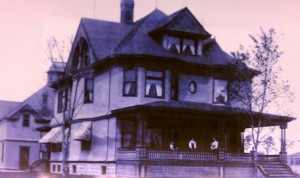
Education
Restoration
Preservation
Welcome to the
Healy Project
Join us on Facebook
Send us an Email
Déjà Vu All Over Again: Threats to Healy Houses Renewed
“Merlin, if you don’t stop whining, I’m going to take Gwen’s sword and beat you to death with it,” said Arthur, evenly.
“It’s plastic.”
“So it will take me a long time. I’m still game.”
― FayJay, The Student Prince
The Orth House at 2320 Colfax Avenue South, which the Minneapolis Heritage Preservation Commission declared an “historic resource” last March, is again facing possible demolition. Owner Michael Crow has submitted an application to the HPC for a permit to wreck an historic resource.
 |
| The Orth House later this year? |
Here’s a summary of the events following up to this renewed attempt to demo the house:
Designed and built by T.P. Healy in 1893, the 6,400 square-foot house is currently a 15-unit rooming house. In the fall of 2012, the Lander Group put forth a proposal to wreck 2320 Colfax and the house next door to clear the site for a 44-unit apartment building. Last February when the owner applied for a wrecking permit for 2320, the Healy Project appealed to the Heritage Preservation Commission. After the HPC declared the house to be an historic resource, Crow appealed to the City Zoning and Planning Commission. The dispute came to a head at the April meeting of Z&P, which denied the owner’s request to overturn the HPC’s ruling.
In this second round in the owner’s effort to get a demolition permit, the process is essentially the same as last year. The HPC will hear Crow’s application at its February 18th meeting. If the HPC allows the permit, demolition can go ahead to clear the site for the Lander Group’s four-story apartment building, unless the Healy Project appeals, which it will. If the HPC denies the permit, Crow can appeal to the City’s Zoning and Planning Commission to overturn the HPC’s decision.
The house has been declared an historic resource, so arguments for demolition will be focused around the economics of development. The cleared land is worth about a third more than the land with the house on it. The owner claims it is his right to sell it for top dollar. No matter that he has had income out of the house for the two decades he owned it, with no improvements to the property except repairs and maintenance. The City in fact would be rewarding a landlord who made only required repairs to his property, while penalizing neighboring homeowners who have invested considerable sums into renovating and restoring their houses. Why are their houses worth more than 2320? Their investment. Why is 2320 worth less than the land it stands on? Crow’s choice to minimally maintain the house as income property.
 |
| The Orth family on the porch of their house (2320 Colfax S.), 1890s. |
Zoning and planning issues (which this is) are hot-button ones. This fight between a developer and the neighborhood will go on at City Hall until the bitter end. Residents in the surrounding neighborhood are banding together to stop Crow and the Lander Group. The Healy Project will continue to fight against the Lander Group’s ill-conceived, wasteful development and advocate for a development plan that incorporates the Orth House.
For more background on the fight to save the Orth House see posts on this blog from January to June 2013.
Meanwhile, across the city. . .
Homeowners in the Healy Block Historic District are fighting to stop the widening of 35W at the 31st Street exit ramp. Nearly three years ago, plans were initiated for the $150 million Transit Access Project (TAP), which calls for a $46 million bus station in the middle of the freeway at Lake Street. The new station will offer easier bus connections to Lake Street and access for bicyclists to the Midtown Greenway. However, along with the station, plans call for expanding the northbound off-ramp by thirty feet, bringing the pavement virtually to the front yards of the famous Healy Queen Anne houses on Second Avenue.

| 1936 photo of Second Ave S. from the 31st Steet intersection |
David Piehl, who lives in the J.B. Hudson House on Second Avenue, has been working with the various government agencies involved to convince them that expanding the highway would render the houses unlivable. In the 1960s construction of 35W took the west side of the block, and since then, traffic has rumbled by the houses 24/7. Piehl points out that living on the block already is stressful. The houses shake, plaster cracks, windows rattle, bathwater ripples. The air on the block is among the most polluted in the state. Bringing the highway even closer would create intolerable emotional stress for the residents and structural stress to the buildings.
 |
| The Hudson House in the days before people sitting on the porch didn’t see a freeway across the street. |
Piehl and other residents of the Healy Block have formed a group called Stop35W to inform the public about this renewed threat to their homes. They have posted signs in their front yards and set up a website (http://stop35w.org/main.php). In November, the Healy Project’s kickoff tour showcased this block to show what kind of woes freeway expansion would amplify on this already-besieged historic area. (See Oct. 31, 2013 post)
Links to articles about the 35Wexpansion:
http://archive-origin.kare11.com/news/article/1046349/14/Mpls-neighbors-fight-proposed-35W-expansion
Commentary about TAP:
 |
| Do not pave up to historic houses. |
Watch this blog and the Healy Facebook page for news about these ongoing battles to preserve the investments of Minneapolis owner-occupants and the architectural legacy of Minneapolis.

